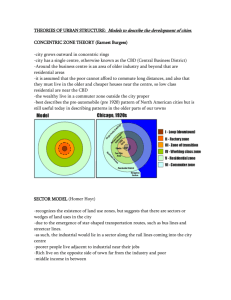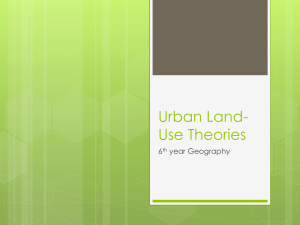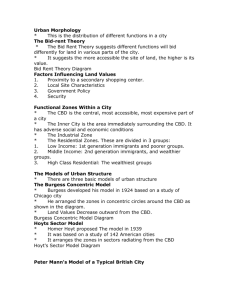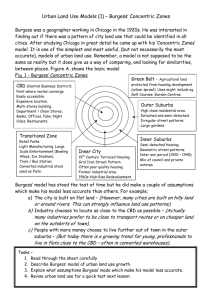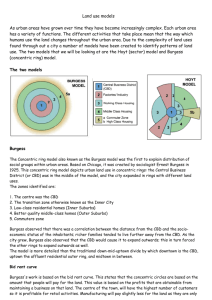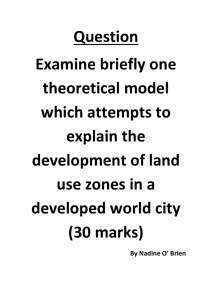The Burgess Model
advertisement
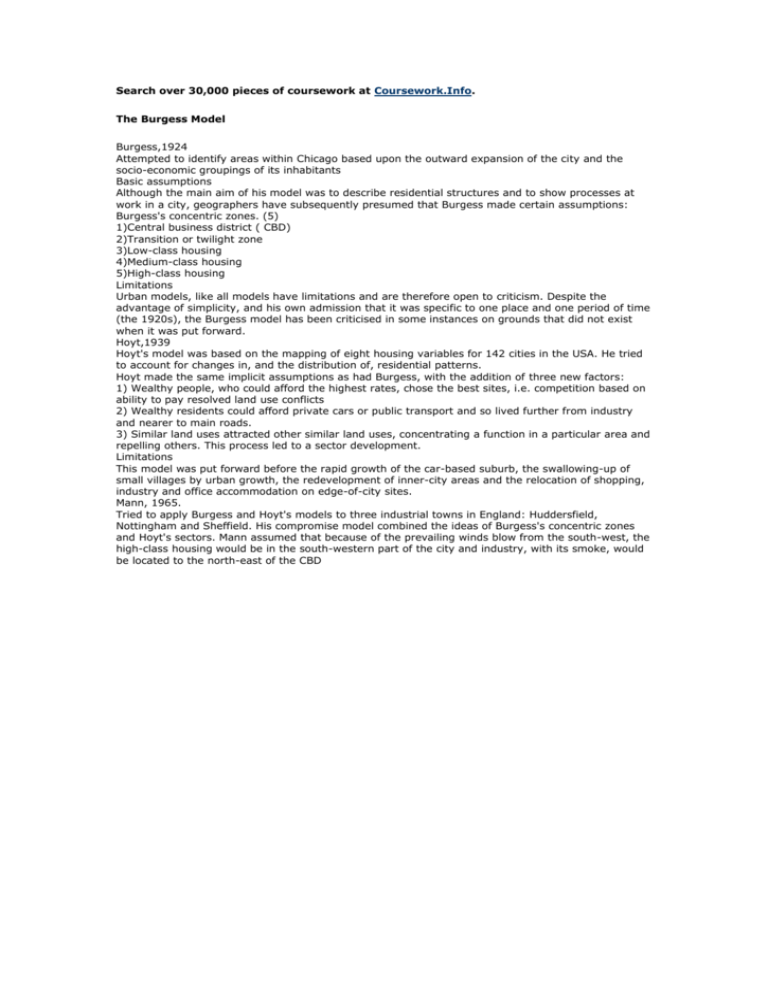
Search over 30,000 pieces of coursework at Coursework.Info. The Burgess Model Burgess,1924 Attempted to identify areas within Chicago based upon the outward expansion of the city and the socio-economic groupings of its inhabitants Basic assumptions Although the main aim of his model was to describe residential structures and to show processes at work in a city, geographers have subsequently presumed that Burgess made certain assumptions: Burgess's concentric zones. (5) 1)Central business district ( CBD) 2)Transition or twilight zone 3)Low-class housing 4)Medium-class housing 5)High-class housing Limitations Urban models, like all models have limitations and are therefore open to criticism. Despite the advantage of simplicity, and his own admission that it was specific to one place and one period of time (the 1920s), the Burgess model has been criticised in some instances on grounds that did not exist when it was put forward. Hoyt,1939 Hoyt's model was based on the mapping of eight housing variables for 142 cities in the USA. He tried to account for changes in, and the distribution of, residential patterns. Hoyt made the same implicit assumptions as had Burgess, with the addition of three new factors: 1) Wealthy people, who could afford the highest rates, chose the best sites, i.e. competition based on ability to pay resolved land use conflicts 2) Wealthy residents could afford private cars or public transport and so lived further from industry and nearer to main roads. 3) Similar land uses attracted other similar land uses, concentrating a function in a particular area and repelling others. This process led to a sector development. Limitations This model was put forward before the rapid growth of the car-based suburb, the swallowing-up of small villages by urban growth, the redevelopment of inner-city areas and the relocation of shopping, industry and office accommodation on edge-of-city sites. Mann, 1965. Tried to apply Burgess and Hoyt's models to three industrial towns in England: Huddersfield, Nottingham and Sheffield. His compromise model combined the ideas of Burgess's concentric zones and Hoyt's sectors. Mann assumed that because of the prevailing winds blow from the south-west, the high-class housing would be in the south-western part of the city and industry, with its smoke, would be located to the north-east of the CBD What are land use models? Landuse models are theories which attempt to explain the layout of urban areas. A model is used to simplify complex, real world situations, and make them easier to explain and understand. There are two main landuse models that apply to urban areas in MEDCS (More Economically Developed Countries). The Burgess Model The model below is the Burgess model (also known as the Concentric Model) The Hoyt Model The model below is the Hoyt model (also known as the Sector Model). Three Models of Urban Land Use The study of urban land use generally draws from three different descriptive models. These models were developed to generalize about the patterns of urban land use found in early industrial cities of the U.S. Because the shape and form of American cities changed over time, new models of urban land were developed to describe an urban landscape that was becoming increasingly complex and differentiated. Further, because these are general models devised to understand the overall patterns of land use, none of them can accurately describe patterns of urban land use in all cities. In fact, all of these models have been criticized for being more applicable to cities in the U.S. than to cities of other nations. Other criticisms have focused on the fact that the models are static; they describe patterns of urban land use in a generic city, but do not describe the process by which land use changes. Despite these criticisms, these models continue to be useful generalizations of the way in which land is devoted to different uses within the city. Below, we will examine the Concentric Zone Model, Sector Model and Multiple Nuclei Model of urban land use. Concentric Zone Model: The concentric zone model was among the early descriptions of urban form. Originated by Earnest Burgess in the 1920s, the concentric zone model depicts the use of urban land as a set of concentric rings with each ring devoted to a different land use (see Figure 1). The model was based on Burgess’s observations of Chicago during the early years of the 20th century. Major routes of transportation emanated from the city’s core, making the CBD the most accessible location in the city. Burgess identified five rings of land use that would form around the CBD. These rings were originally defined as the (1) central business district, (2) zone of transition, (3) zone of independent workers’ homes, (4) zone of better residences and (5) zone of commuters. An important feature of this model is the positive correlation of socio-economic statuts of households with distance from the CBD -- more affluent households were observed to live at greater distances from the central city. Burgess described the changing spatial patterns of residential areas as a process of "invasion" and "succession". As the city grew and developed over time, the CBD would exert pressure on the zone immediately surrounding it (the zone of transition). Outward expansion of the CBD would invade nearby residential neighborhoods causing them to expand outward. The process was thought to continue with each successive neighborhood moving further from the CBD. He suggested that innercity housing was largely occupied by immigrants and households with low socio-economic status. As the city grew and the CBD expanded outward, lower status residents moved to adjacent neighborhoods, and more affluent residents moved further from the CBD. Figure 1 Three Generalizations of Urban Structure Upper Left: Burgess' Concentric Zone Model; Upper Right: Hoyt's Sector Model; Bottom Left: Harris and Ullman Multiple Nuclei Model. Graphic repared by Department of Geography and Earth Sciences, University of North Carolina at Charlotte. Sector Model: Soon after Burgess generalized about the concentric zone form of the city, Homer Hoyt re-cast the concentric ring model. While recognizing the value of the concentric ring model, Hoyt also observed some consistent patterns in many American cities. He observed, for example, that it was common for low-income households to be found in close proximity to railroad lines, and commercial establishments to be found along business thoroughfares. In 1939, Hoyt modified the concentric zone model to account for major transportation routes. Recall that most major cities evolved around the nexus of several important transport facilities such as railroads, sea ports, and trolly lines that eminated from the city's center. Recognizing that these routes (and later metropolitan expressways and interstate highways) represented lines of greater access, Hoyt theorized that cities would tend to grow in wedge-shaped patterns, or sectors, eminating from the CBD and centered on major transportation routes. Higher levels of access translate to higher land values. Thus, many commercial functions would remain in the CBD, but manufcaturing activity would develop in a wedge surrounding transport routes. Residential land use patterns also would grow in wedge-shaped patterns with a sector of lower-income households bordering the manufacturing/ warehousing sector (traffic, noise and pollution making these less desirable locations to live) and sectors of middle- and higherincome households located away from industrtial sites. In many respects, Hoyt's sector model is simply a concentric zone model modified to account for the impact of transportation systems on accessibility. Multiple Nuclei Model: By 1945, it was clear to Chauncy Harris and Edward Ullman that many cities did not fit the traditional concentric zone or sector model. Cities of greater size were developing substantial suburban areas and some suburbs, having reached significant size, were functioning like smaller busniess districts. These smaller business districts acted as satellite nodes, or nuclei, of activity around which land use patterns formed. While Harris and Ullman still saw the CBD as the major center of commerce, they suggested that specialized cells of activity would develop according to specific requirements of certain activities, different rent-paying abilities, and the tendency for some kinds of economic activity to cluster together. At the center of their model is the CBD, with light manufacturing and wholesaling located along transport routes. Heavy industry was thought to locate near the outer edge of city, perhaps surrounded by lower-income households, and suburbs of commuters and smaller service centers would occupy the urban periphery.
